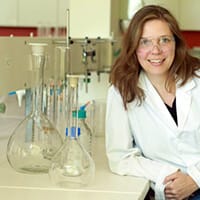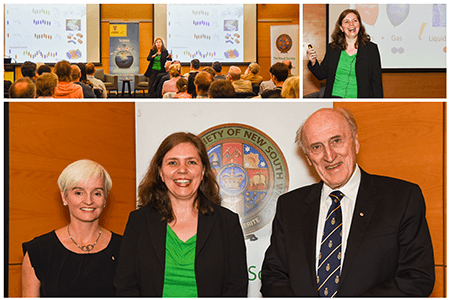
Report on the 2018 Royal Society of NSW Liversidge Lecture — Scientia Professor Martina Stenzel
 The 2018 Liversidge Lecture of the Royal Society of NSW was delivered at UNSW Sydney on the evening of Thursday, 20 February 2020 by Scientia Professor Martina Stenzel FAA of the UNSW School of Chemistry. Professor Stenzel was introduced by Professor Emma Johnston AO FTSE FRSN, Dean of Science at UNSW, and Emeritus Professor Ian Sloan AO FAA FRSN, President of the Royal Society of NSW, who spoke about the Society and of the prominent role played in its early history by Professor Archibald Liversidge, whose bequest founded the Liversidge Medal and Lecture which is awarded biennially. The 2018 awardee, Professor Martina Stenzel, then presented a fascinating story – a story with two strands.
The 2018 Liversidge Lecture of the Royal Society of NSW was delivered at UNSW Sydney on the evening of Thursday, 20 February 2020 by Scientia Professor Martina Stenzel FAA of the UNSW School of Chemistry. Professor Stenzel was introduced by Professor Emma Johnston AO FTSE FRSN, Dean of Science at UNSW, and Emeritus Professor Ian Sloan AO FAA FRSN, President of the Royal Society of NSW, who spoke about the Society and of the prominent role played in its early history by Professor Archibald Liversidge, whose bequest founded the Liversidge Medal and Lecture which is awarded biennially. The 2018 awardee, Professor Martina Stenzel, then presented a fascinating story – a story with two strands.
The first reflected on her own professional journey from early school days in Germany through a succession of university studies, ending up as a post-doctoral researcher at UNSW two decades ago, from which time it has been a continuous success story, up to her present position as a Scientia Professor, with numerous awards along the way. The other strand was the story of the development of polymers, long rows of linked organic molecules, which started with a challenge, in the 1860’s, to make synthetic billiard balls as a replacement for ivory balls. However, the winner, who pocketed $10,000 in prize money, had little idea of what was taking place in the mixture of materials he had come up with in a cut-and-try process, and it was not until 1920 that the theoretical foundations of polymerisation were established.
 There followed the development of numerous materials through polymerisation, which we know under the collective term of “plastics” today, but in these materials the length of polymers would vary immensely, from a few hundred to a hundred thousand of the organic building blocks, whereas the polymers found in Nature (and there are many of them) all have very definite lengths. Through studying them, it was found that by adding a certain type of molecule to the polymerising mixture, the length could be controlled reasonably accurately. With this, the basis was established for Martina’s main interest – the creation of nano-sized polymers with various shapes, one of which is a sphere or ball, with a core of hydrophobic material and an outer shell of hydrophilic material. As cancer drugs are mostly hydrophobic, they can be embedded in the core, and by attaching particular molecules to the polymers making up the shell, the nanoparticles will attach themselves predominantly to cancer cells, penetrate the cells, and release the drug.
There followed the development of numerous materials through polymerisation, which we know under the collective term of “plastics” today, but in these materials the length of polymers would vary immensely, from a few hundred to a hundred thousand of the organic building blocks, whereas the polymers found in Nature (and there are many of them) all have very definite lengths. Through studying them, it was found that by adding a certain type of molecule to the polymerising mixture, the length could be controlled reasonably accurately. With this, the basis was established for Martina’s main interest – the creation of nano-sized polymers with various shapes, one of which is a sphere or ball, with a core of hydrophobic material and an outer shell of hydrophilic material. As cancer drugs are mostly hydrophobic, they can be embedded in the core, and by attaching particular molecules to the polymers making up the shell, the nanoparticles will attach themselves predominantly to cancer cells, penetrate the cells, and release the drug.
The whole story, from billiard ball to cancer delivery, had the appearance of a fairy-tale – every time a problem blocked further progress a solution was miraculously found – but it was, of course, no fairy-tale; it was the story of a huge amount of hard work and dedication. And, above all, as Martina emphasised several times, it was the result of collaboration between disciplines – physics, chemistry, biology, and also medicine – and she summed up the moral of the story with “A successful team is better than a team of successful people”.